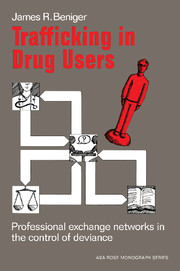Book contents
- Frontmatter
- Contents
- Acknowledgments
- Introduction
- 1 The emergence of the “drug problem”: social change versus social control
- 2 Control systems from exchange in networks: toward a synthesis of system and action theory
- 3 Stratification in information and referral exchange
- 4 Exchange relationships in social-control systems
- 5 The social system: boundary maintenance and hierarchical control
- 6 Summary: the control system in context
- Appendix A The data set
- Appendix B Subgroup sampling and estimated-density spaces (EDS)
- Notes
- Bibliography
- Name index
- Subject index
- Frontmatter
- Contents
- Acknowledgments
- Introduction
- 1 The emergence of the “drug problem”: social change versus social control
- 2 Control systems from exchange in networks: toward a synthesis of system and action theory
- 3 Stratification in information and referral exchange
- 4 Exchange relationships in social-control systems
- 5 The social system: boundary maintenance and hierarchical control
- 6 Summary: the control system in context
- Appendix A The data set
- Appendix B Subgroup sampling and estimated-density spaces (EDS)
- Notes
- Bibliography
- Name index
- Subject index
Summary
This is a case study of one of the most dramatic social changes in American history, the rapid increase in the late 1960s in illegal drug use and abuse, especially among the youth of the nation. Although much has been written attempting to explain this development, I have not even bothered to review the literature and do not care to contribute to it. For me, the phenomenon is interesting only as exogenous change, a sharp, strong disturbance of a society's system for the control of social deviance – about as close an approximation to a laboratory test of such a system that a sociologist is likely to achieve, and hence an unusual opportunity to learn more about how social-control systems work.
It may seem insensitive to speak so abstractly about a major national problem fraught with human suffering. Such language is wholly intentional. Indeed, not only have I chosen to ignore the compelling human aspects of drug abuse by the young, I have largely ignored the young altogether. When I mention them at all, which is infrequent, it is usually as “professional referrals” or, in the aggregate, as “commodity flows to be controlled.” I do this not because I am without feeling for the young or their problems, which have in fact touched me personally in several ways, but because I believe such problems can only be a distraction from the aim of my study: to understand the containment of rapid social change by the interorganizational community of professional specialists – medical, legal, educational, and counseling – that constitutes the total system for the control of social deviance.
- Type
- Chapter
- Information
- Trafficking in Drug UsersProfessional Exchange Networks in the Control of Deviance, pp. 1 - 6Publisher: Cambridge University PressPrint publication year: 1984



